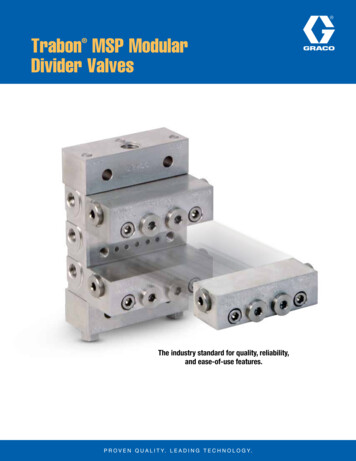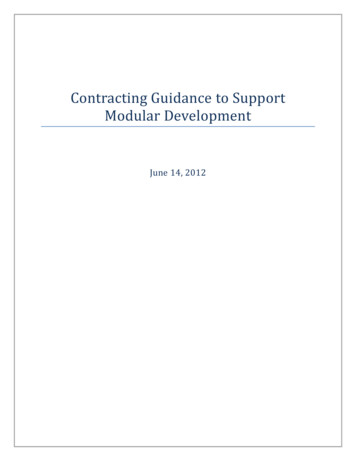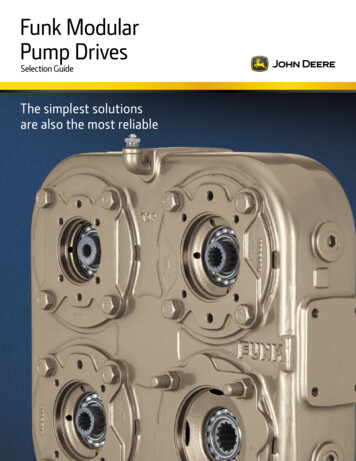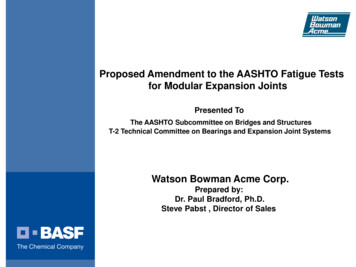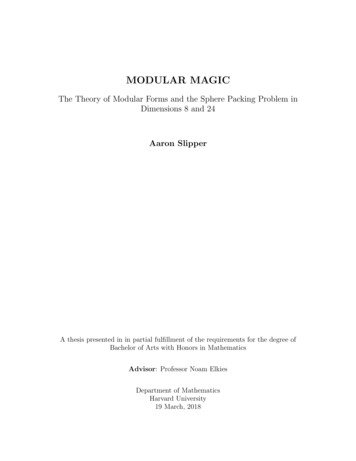
Transcription
Electronic Supplementary Material (ESI) for Organic & Biomolecular Chemistry.This journal is The Royal Society of Chemistry 2020Supporting InformationModular Control of L-Tryptophan Isotopic Substitution viaan Efficient Biosynthetic CascadeThompson, C. M.; McDonald, A. D.; Yang, H.; Cavagnero, S.*; Buller, A. R.*Department of Chemistry, University of Wisconsin-Madison1101 University Avenue Madison, WI 53706*corresponding authors: Andrew R. Buller, email:arbuller@wisc.edu; Silvia Cavagnero, email:cavagnero@chem.wisc.eduTable of contents1. General information22. Experimental section22.1 Materials22.2 Methods22.2.1 Cloning, expression, and purification of PfTrpB2B9 and TmLTA 22.2.2 Optimization of TmLTA-TrpB2B9 cascade32.2.3 Preparative-scale synthesis of Trp isotopologs42.2.4 Analytical- and preparative-scale chromatography52.2.5 Determination of enantiopurity of Trp isotopologs52.2.6 NMR analysis63. Characterization of Trp and Trp isotopologs74. Supporting references105. Supporting tables and figures11 - 17 1
1. General informationThe glassware used in the reactions carried out in this work was thoroughly washed, andall experiments were executed following necessary safety precautions. Evaporation of solventswas performed at reduced pressure using a rotary evaporator. Electronic-absorption measurementswere done with a UV-2600 spectrophotometer (Shimadzu).2. Experimental section2.1. MaterialsChemicals and solvents were obtained from commercial suppliers and used without furtherpurification: formaldehyde-D2 (Cambridge Isotope Laboratories, Inc.); (2-13C)glycine(Cambridge Isotope Laboratories, Inc.); D2O 99.9% (Sigma-Aldrich); indole (SigmaAldrich); pyridoxal 5’ monophosphate; scale reaction products were analyzed by UPLC/LC-MS on an Acquity UHPLCapparatus equipped with an Acquity QDA MS detector (Waters), using an Acquity UPLCCSH Phenyl-Hexyl column (Waters). Preparative-scale flash chromatographic separationswere performed on an Isolera One Flash Purification system (Biotage). NMR analysis wascarried out on either a Bruker AVANCE 400 NMR spectrometer or Bruker AVANCE 600NMR spectrometer.2.2. Methods2.2.1 Cloning, expression, and purification of PfTrpB2B9 and TmLTACodon-optimized copies of the engineered Pyrococcus furiosus tryptophan synthase βsubunit (PfTrpB2B9) and Thermotoga maritima L-threonine aldolase (TmLTA, EC 4.1.2.5) 2
genes were purchased as gBlocks from Integrated DNA Technologies.1 These DNAfragments were inserted into pET22b vectors via Gibson Assembly.2 BL21 (DE3) E. colicells were separately transformed with plasmids encoding each of the above proteins viaelectroporation. After 30 min of growth in Luria Bertani (LB) broth at 37 C, cells wereplated onto LB plates in the presence of 100 μg/mL ampicillin (amp) and incubatedovernight. Single colonies were used to inoculate 2 x 5 mL Terrific Broth (TB) containing100 μg/mL amp, followed by overnight growth at 37 C. Expression cultures, typicallyconsisting of 1 L of TB and 100 μg/mL amp, were inoculated with the above starter cultureencoding the gene of the desired protein and shaken (180 rpm) at 37 C. After 3 h (OD600 1.5), the cultures were chilled on ice for 60 min. Protein overexpression was inducedupon addition of 1 mM isopropyl β-D-thiogalactopyranoside (IPTG). Cultures wereexpressed overnight at 23 C upon shaking at 200 rpm. Cell were then harvested uponcentrifugation at 4300 x g at 4 C for 30 min. Cell pellets were then immediately subject tolysis or stored frozen at -20 C until needed.When stored frozen, cell pellets were thawed on ice. Cells were then resuspended in lysisbuffer (50 mM potassium phosphate buffer pH 8.0, 1 mg/mL hen egg white lysozyme(GoldBio), 0.2 mg/mL DNaseI (GoldBio), 1 mM MgCl2 and 400 μM pyridoxal 5′phosphate (PLP). A volume of 4 mL of lysis buffer was used per each gram of wet cellpellet. After 30 min under shaking at 37 C, the resuspended lysis mixture was heated for10 min at 75 C. The resulting lysate was spun down at 75,600 x g to pellet cell debris andother insoluble products. Ni/NTA beads (GoldBio) were added to the supernatant andincubated on ice for 40 min prior to purification by Ni-affinity chromatography. Thecolumn was washed with 3 column volumes of 20 mM imidazole, 50 mM potassium 3
phosphate adjusted to pH 8.0, 3 column volumes of 40 mM imidazole, 50 mM potassiumphosphate adjusted to pH 8.0 and eluted with 250 mM imidazole, 50 mM potassiumphosphate buffer pH 8.0. Elution of the desired protein was monitored by eye inspectionvia the disappearance of the bright-yellow column band arising from the protein-associatedPLP cofactor. Note that PLP associates to both PfTrpB2B9 and TmLTA. Solutions weredialyzed to 1 μM imidazole, flash-frozen by dripping into liquid nitrogen and stored at 80 C. Protein concentration was estimated via a Bradford assay. The above procedureyielded 500 mg PfTrpB2B9per L culture and 1000 mg TmLTA per L culture. SDS-Pageanalysis of the expression mixture and purified enzymes is shown in Figure S1.2.2.2 Optimization of TmLTA-TrpB2B9 cascadeAnalytical-scale reactions to determine optimal conditions forL-tryptophan(Trp)production for the TmLTA-PfTrpB2B9 cascade were performed in 5 mL glass vials inquadruplicate (final volume 500 μL). Reactions were performed in the presence of 5 mMGly, 2.5 – 10 mM indole, 0.004 – 0.04 μM TmLTA, 0.004 – 0.04 μM PfTrpB2B9, 0.02 mMPLP, 3.75 – 7.5 mM formaldehyde and 50 mM potassium phosphate adjusted to pH 8.0(Fig. 2). All reactants and catalysts were prepared as stock solutions in 50 mM potassiumphosphate adjusted to pH 8.0. Reactions were carried out for 16 h at 50 C and quenchedwith 500 μL 1:1 MeOH: 1 M HCl, followed by vortexing and centrifugation at 20,000 x gfor 10 min, to pellet down the enzymes. The amount of Trp in the supernatant wasquantified via UPLC-MS by integrating the single-ion peak with m/z 1 205.09. Toassess the amount of generated product (Trp, see Supporting Table S2), peak intensitieswere compared to those of a Trp standard of known concentration via a calibration curve. 4
2.2.3 Preparative-scale synthesis of Trp isotopologs(2-2H)TrpThe reactants below were added in the following order to a capped high-pressure flask:indole (11.7 mg, 0.1 mmol), L-serine (32.0 mg, 0.3 mmol) and PfTrpB2B9 enzyme (4.3 mg,0.1 μmol). The total reaction volume was adjusted to 5 mL with 50 mM potassiumphosphate in D2O, with pD 8.0. pD was determined by a pH electrode according to: pD pH 0.42.3 The buffer pH was adjusted to 7.6 with DCl. Likewise, all reagent stocksolutions were in D2O and contained 50 mM potassium phosphate at pD 8.0. The reactionmixture was incubated overnight at 75 C. The reaction solution was incubated at 90 C for15 min to heat-quench. The enzymes were then removed from the post-reaction mixtureupon centrifugation at 20,000 x g for 10 min. The Trp isotopolog was purified via an IsoleraOne Flash Purification system (Biotage) under isocratic conditions (10% MeOH, 90%H2O). Samples containing desired Trp isotopolog were pooled and evaporated to dryness.Dried samples were resuspended in water, frozen, and lyophilized to remove excesssolvent. The lyophilized samples were weighed. Identity was assessed and purity wasconfirmed by 1H- and 13C-NMR.(2-13C, 2, 3, 3-2H3)TrpThe reactants below were added in the following order to a capped high-pressure flask:indole (4.1 mg, 0.035 mmol), 50 mM potassium phosphate (6.75 mL), (2-13C) glycine (Gly,70 μL of 0.5 M material, i,e., 0.035 mmol), PLP (7.00 μL of 20 mM PLP, i.e., 0.14 μmol),PfTrpB2B9 (1.5 mg, 0.035 μmol) and TmLTA (1.3 mg, 0.035 μmol) enzymes, 5
formaldehyde-D2 (70 μL of 0.500 M material, 0.035 mmol). The final volume was adjustedto 7 mL with 50 mM potassium phosphate at pD 8.0, respectively. All reagent stocksolutions were in D2O and contained 50 mM potassium phosphate at pD 8.0. The reactionmixture was incubated overnight at 50 C. The reaction solution was incubated at 90 C for15 min to heat-quench. The enzymes were then removed from the post-reaction mixtureupon centrifugation at 20,000 x g for 10 min. The Trp isotopolog was purified via an IsoleraOne Flash Purification system (Biotage) under isocratic conditions (10% MeOH, 90%H2O). Samples containing desired Trp isotopolog were pooled and evaporated to dryness.Dried samples were resuspended in water, frozen, and lyophilized to remove excesssolvent. Lyophilized samples were weighed, and purity / identity were assessed by 1H- and13C-NMR.2.2.4 Analytical- and preparative-scale chromatographyAnalytical-scale reaction products were analyzed by UPLC/LC-MS on an Acquity UHPLCapparatus equipped with an Acquity QDA MS detector (Waters), using an Acquity UPLCCSH Phenyl-Hexyl column (Waters). Preparative-scale flash chromatographic separationswere performed on an Isolera One Flash Purification system (Biotage).2.2.5 Determination of enantiopurity of Trp isotopologsEnantiopurity of the Trp isotopologs was assessed upon treatment with the Marfey’sreagent analog 2-(5-fluoro-2,4-dinitrophenyl)amino- L-valinamide (FDVA) as described.4Briefly, 1 mM of the newly synthesized Trp isotopolog (or a standard consisting of a D/LTrp mixture of known concentration) were mixed with 5 mM FDVA, 400 mM sodiumbicarbonate in a 100 μL solution of 20:80 acetonitrile:H2O (v/v) and incubated for 2 h at40 C. The reaction was quenched with 200 μL of 1:1 acetonitrile:1 M HCl (v/v), followed 6
by UPLC-MS analysis. Enantiopurity of the Trp isotopologs was assessed upon comparisonwith standards composed of a D-Trp/L-Trp mixture of known concentration (Fig. S2).2.2.6 NMR characterization of synthesized compoundsThe extent of13C- and 2H-incorporation at the α- and β-positions of deuterated Trpisotopologs was determined by 1H and13C nuclear magnetic resonance (1H,13C NMR,pulse-acquire experiments) on a 400 MHz Bruker Avance spectrometer in D2O, in thepresence of trace amounts of 4,4-dimethyl-4-silapentane-1-sulfonic acid (DSS), employedas an internal chemical-shift standard.All other 1H NMR data were collected on a Bruker 600 MHz spectrometer equipped withan Avance III HD console and a cryogenic 1H/13C/15N TCI-F probe. NMR experimentswere carried out in 90% H2O and 10% D2O with presaturation of the HDO-resonance (4.70ppm).1D 1H spectra were acquired with a 15.97 ppm sweepwidth, 38,312 total points and 8 scans.All 1H spectra were zero-filled to 65,536 complex points and apodized with an exponentialwindow function (0.5 Hz line-broadening).1D 13C spectra were acquired with 1H and 2H decoupling during acquisition, a 282.5 ppmsweepwidth centered at 110 ppm and 71,424 total points. A variable number of scans wereacquired until a suitable S/N was achieved. All13C spectra were zero-filled to 131,072complex points and apodized with an exponential window function (1 Hz linebroadening).13Cα longitudinal relaxation times (T1) of Trp isotopologs were determined via theinversion recovery pulse sequence with 1H and 2H decoupling during acquisition.13Cαtransverse relaxation times (T2) were assessed with the Carr-Purcell-Meiboom-Gill(CPMG) pulse sequence in the presence of 1H and 2H decoupling during both evolution and 7
acquisition times. T1 and T2 data had the same acquisition parameters as the other13Cexperiments, except that the center frequency was set to 55 ppm (i.e., centered on Cαresonances) to prevent undesired off-resonance effects.3. Characterization of Trp and Trp isotopologsL-tryptophanOOHNH2NHWhite solid (Sigma-Aldrich); 1H NMR (600 MHz, 90% H2O, 10% D2O) δ 7.72 (d, J 7.9 Hz,1H), 7.53 (d, J 8.2 Hz, 1H), 7.30 (d, J 1.78 Hz, 1H), 7.27 (t, J 7.6 Hz, 1H), 7.19 (t, J 7.5Hz, 1H), 4.04 (dd, J 4.82, 8.1 Hz, 1H), 3.47 (dd, J 15.4, 4.8 Hz, 1H), 3.28, (dd, J 15.4, 8.1Hz, 1H); 13C NMR (151 MHz, 90% H2O, 10% D2O) δ 174.60, 136.50, 126.72, 125.25, 122.18,119.53, 118.51, 112.06, 107.60, 55.28, 26.53 (Figs. S3 and S4). 8
(2-2H)-L-tryptophanOOHDNH2NHYield 89% (18.2 mg); white solid; 1H NMR (600 MHz, 90% H2O, 10% D2O) δ 7.73 (d, J 7.9Hz, 1H), 7.53 (d, J 8.1 Hz, 1H), 7.31 (s, 1H), 7.28 (t, J 7.6 Hz, 1H), 7.20 (t, J 7.5 Hz, 1H),3.46 (d, J 15.4, 1H), 3.28, (dd, J 15.3, 1H);13C NMR (151 MHz, 90% H2O, 10% D2O) δ174.50, 136.36, 126.58, 125.10, 122.04, 119.38, 118.37, 111.91, 107.47, 54.83, 26.30 (Figs S5 andS6).(2-13C, 2, 3, 3-2H3)-L-tryptophanDDO13COHDND2NHYield 60% (4.8 mg); white solid; 1H NMR (600 MHz, 90% H2O, 10% D2O) δ 7.73 (d, J 7.9 Hz,1H), 7.53 (d, J 8.2 Hz, 1H), 7.29 (s, 1H), 7.27 (t, J 7.6 Hz, 1H), 7.19 (t, J 7.5 Hz, 1H); 13CNMR (151 MHz, 90% H2O, 10% D2O) δ 136.45, 126.85, 125.08, 122.11, 119.46, 118.59, 112.01,55.10 (Figs S7 and S8). 9
4. Supporting references1D. K. Romney, J. Murciano-Calles, J. E. Wehrmüller and F. H. Arnold, J. Am. Chem.Soc., 2017, 139, 10769–10776.2D. G. Gibson, L. Young, R.-Y. Chuang, J. C. Venter, C. A. Hutchison and H. O. Smith,Nat. Methods, 2009, 6, 343–345.3A. Krezel and W. Bal, J. Inorg. Biochem., 2004, 98, 161–166.4P. Marfey, Carlsb. Res. Commun., 1984, 49, 591–596. 10
5. Supporting tables and figuresTable S1. Reaction yields and enantiomeric excess of Trpaisotopologs prepared in this work.aAll reactions were carried out in 50 mM potassium phosphate in D2O, atpD 8.0.bEnantiomeric excess was determined via UPLC-MS after derivatization ofthe reaction products with a Marfey’s reagent analog (see section 2.2.5). 11
Table S2. Overview of tested experimental conditions (analytical scale) for thesynthesis of Trp via the TmLTA-PfTrpB2B9-mediated cascade introduced in this work.EntryaEq./ Conc.YieldbYield Std. error[Trp] (mM) inStd. errorpost- [Trp]reaction(%)(%)mixture(mM)14 μM2956128 μM4328.70.3320 μM784161440 μM79416150.5 eq.3938160.75 eq.61312171.0 eq.80816282.0 eq.75815290.75 eq.816161101.0 eq.799162111.5 eq18541125 mM97104.80.51310 mM9149.10.41420 mM7571511540 mM485192Entries 1-4: [enzymes], with: 1:1 PfTrpB2B9 and TmLTA; entries 4-8: indole equivalents (relative to glycine); entries9-11: formaldehyde equivalents (relative to glycine); entries 12-15: reactant concentration (1: 1: 1 glycine: indole:formaldehyde) with 0.001 eq. of PfTrpB2B9 and TmLTA.bTrp assessed via UPLC-MS, single-ion m/z 1 205.09.a 12
Figure S1. SDS-Page analysis of purified Pf TrpB2B9 and TmLTA enzymes. 13
Figure S2. Chromatogram highlighting (2-13C, 2, 3, 3-2H3)Trpisotopolog derivatized with FDVA (see section 2.2.6) to assessenantiomeric purity. The additional peak on the left hand side(retention time 4.1 min) is due to 1,5-difluoro, 2,4dinitrobenzene after the synthesis. 14
Figure S3. 1H NMR spectrum of Trp (8 scans).Figure S4. 13C NMR spectrum of Trp (with 1H-, 2Ddecoupling during acquisition, 8 scans). 15
Figure S5. 1H NMR spectrum of (2-2H)Trp (8 scans).Figure S6.13C NMR spectrum of (2-2H)Trp (512 scans). 16
Figure S7. 1H NMR spectrum of (2-13C, 2, 3, 3-2H3)Trp (8 scans).Figure S8. (a) 13C NMR spectrum of (2-13C, 2, 3, 3-2H3)Trp (512 scans), 1H and2H decoupled. (b) Comparison 13C NMR spectra of (2-13C, 2, 3, 3-2H3)Trp (2scans), in the absence and presence of 2H decoupling. 17
Analytical-scale reaction products were analyzed by UPLC/LC -MS on an Acquity UHPLC apparatus equipped with an Acquity QDA MS detector (Waters), using an Acquity UPLC CSH Phenyl-Hexyl column (Waters). Preparativescale flas- h chromatographic separations were performed on an Isolera One Flash Purification system (Biotage).
